Intel Xeon 6700P Power Consumption
Intel is doing something interesting. Instead of focusing on idle and peak power, it is optimizing in the 40-60% utilization range. It is now shipping its CPUs with a performance profile focused on saving power in that range, but with the option to select a more latency-sensitive and higher power profile.
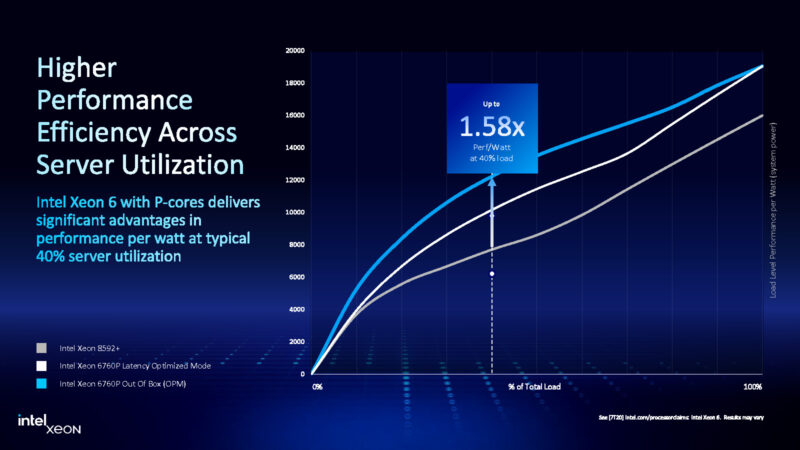
Something we thought was neat was that with a very significant configuration with two NICs, one 400Gbps NVIDIA ConnectX-7, 1TB (16x 64GB) of DDR5, over 200TB of storage, and the 80-core Intel Xeon 6781P, we were consistently idling below 95W in a 1U single-socket platform. That is very good compared with many of Intel’s recent platforms. For example, a 56-core Sapphire Rapids platform with 16 DIMMs installed and a 400Gbps NIC will not idle at under 100W.
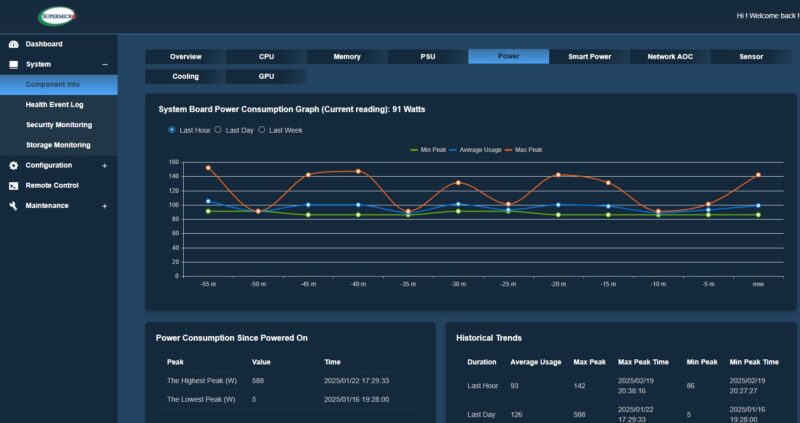
Looking at the package power consumption, we were seeing between 50-55W reported.
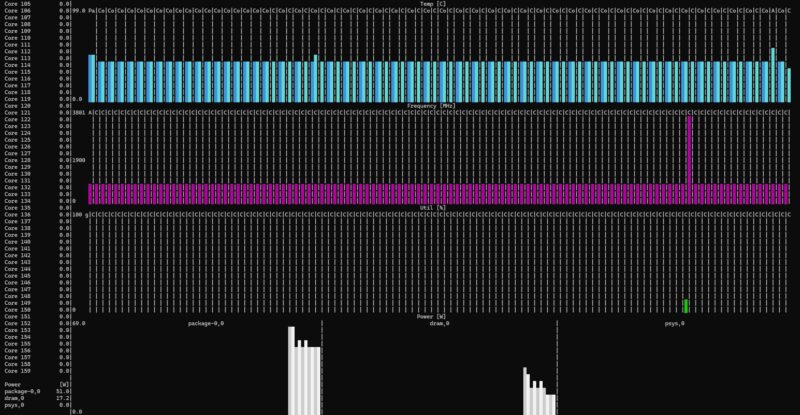
Under load, we got the system up to 588W, but when just loading the CPUs, we were closer to 470-495W, which included an extra ~1W per DIMM on the memory side when running this.
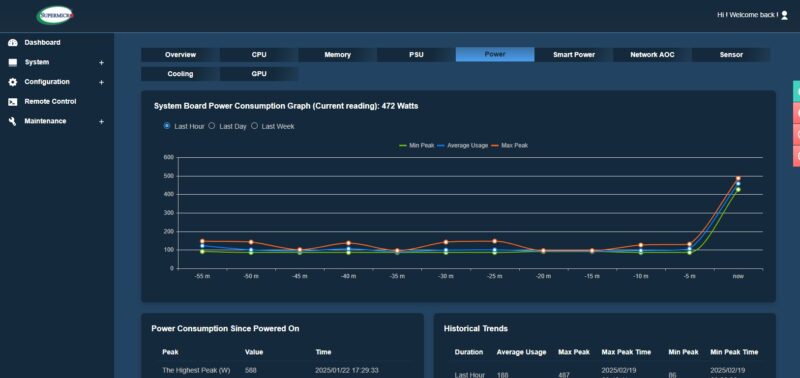
The package itself ran in the 340-350W range.
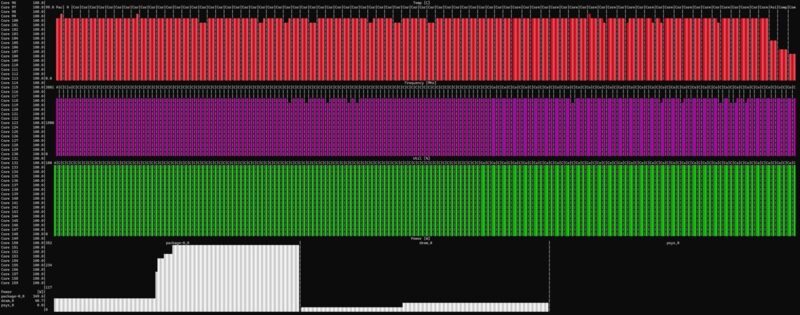
This might not seem substantial, but let us reframe it in the context of recent server CPUs. This is a sub-$9000 single socket CPU with 136 PCIe Gen5 lanes that is performing better than a dual Intel Xeon Platinum 8380 launched just under four years ago and that was state-of-the-art Xeon until just over two years ago.
The Xeon 6 R1S server at 500W uses around 54% of the power of the dual Platinum 8380 server at the same core count. Even without the slew of new accelerators added with Xeon 6, it is faster. The single-socket Xeon 6 R1S also offers more than twice the PCIe bandwidth as the dual Xeon 8380. Getting more capability in around half the cost and half the power of 25-month-old top-end parts, is really neat.
Key Lessons Learned
It is pretty easy to say that AMD has more cores at 192 cores/ 384 threads. It is also easy to say that Intel and AMD have 128 core parts that are competitive. The fact is, however, that a large number of non-hyper-scale CPU purchases are done at much lower core counts.
If we take a step back and look at that market, perhaps that is what Intel is focusing on. It has two CPU lines in that 150W to 350W TDP range. If you want to go cloud-native and run your nginx web servers on a low-power core, then the Intel Xeon 6700E, specifically the Xeon 6766E with 144 cores at 250W, is very exciting. Likewise, if you want to run a basic 16-core Windows Server 2025 server or a 32-core VMware server, Intel has options that lower the price of entry significantly.
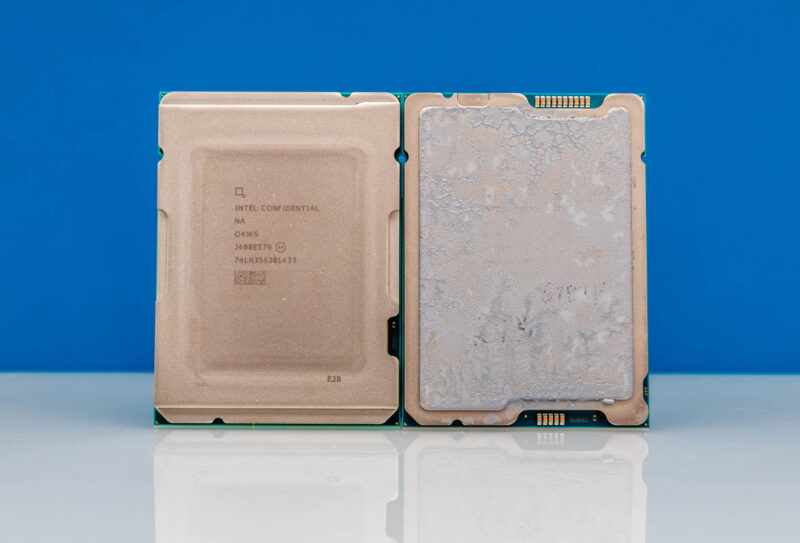
Perhaps more importantly, Intel has options running at lower power envelopes. The Xeon 6900P series may get headlines with 128 cores, but it feels like the Xeon 6700P and 6500P will move units. AMD tends to do well in the hyper-scale market where high core count CPUs are preferred. For others, the lower-core count smaller platforms will be more practical.
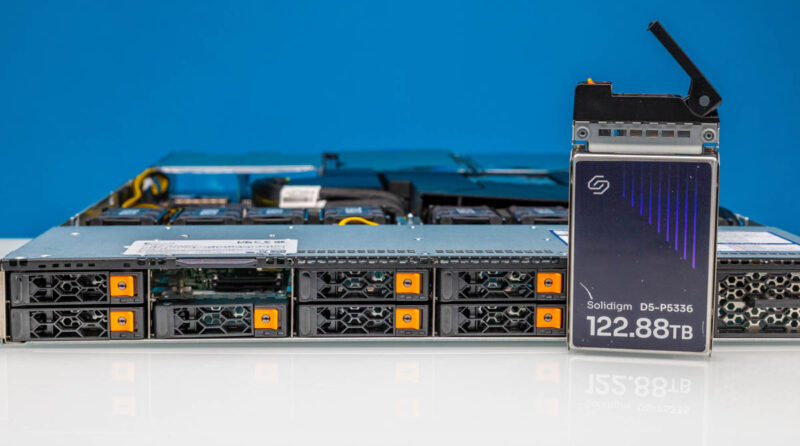
If you just want a lot of I/O, then Intel’s single socket SKUs are becoming compelling. For the first time in a long time, we can say Intel has (slightly) more PCIe bandwidth than AMD EPYC in a single socket. The idea of the R1S platform with 122.88TB NVMe SSDs in the front and 400GbE NICs at the rear should be inspiring to the storage folks.
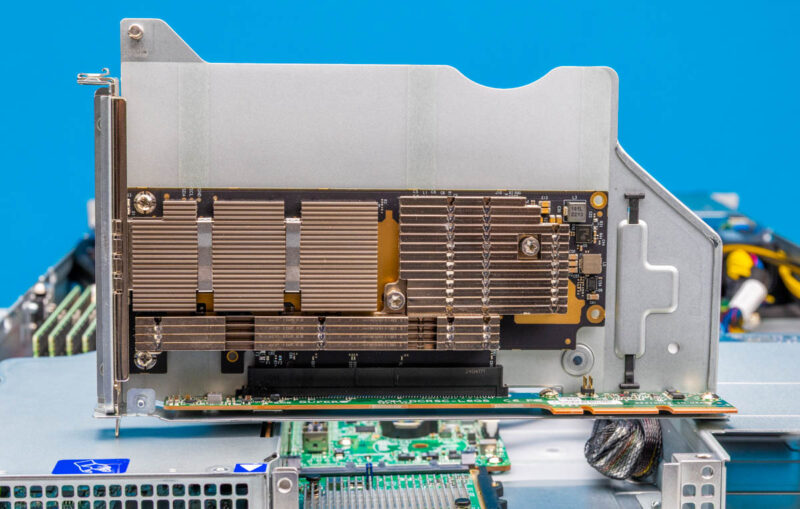
What is becoming interesting in the server market today is that Intel Xeon is following a strategy of micro segmentation, while AMD EPYC is offering fewer SKUs and growing its market share.
Final Words
Intel, from a corporate perspective, is in the news regularly, and perhaps not in the best light. With the Intel Xeon 6700P series, we can at least see what the folks at Intel had planned for Xeon 6. Those that would leave Intel for dead based on market share losses and stock price challenges should not do the same with its products. AMD is hunting aggressively at the top-end, but this midrange/ enterprise segment is where the Intel Xeon 6700P does well. We looked at Rangely in early 2014 with the Intel Atom C2758. It has taken 11+ years since that chip, but we now have universal QAT acceleration on mainstream Xeons.
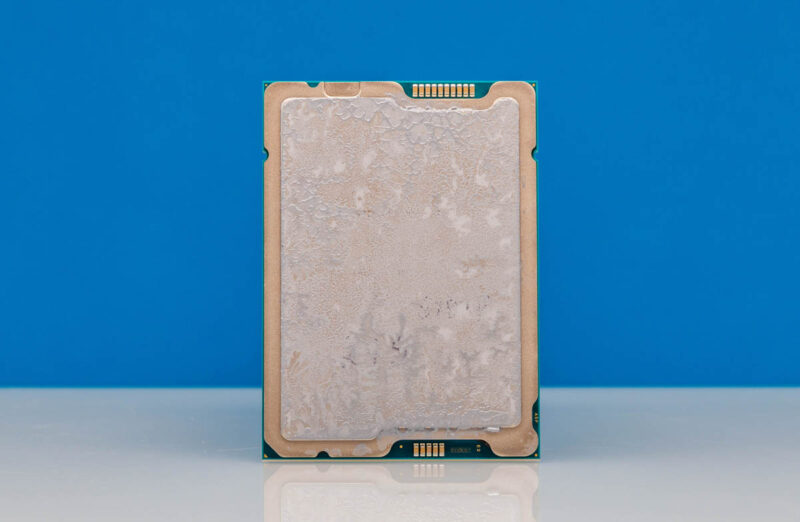
If an organization has older 2nd Gen Intel Xeon Scalable “Cascade Lake” servers, the new generation offers 3:1 to 10:1 consolidation ratios while also offering new features. We discussed a 400Gbps NIC, but a single Cascade Lake Xeon did not have enough total PCIe bandwidth to drive a single 400Gbps NIC. The other big one is going to be the R1S. If you just want to simplify operations down to a single socket and do not want to enter the realm of larger and more power-hungry sockets, then the R1S is worth looking at. Many will not because they are accustomed to dual-socket servers. Still, the single socket server is something many can now look at, even if they are an organization that only shops Xeon.
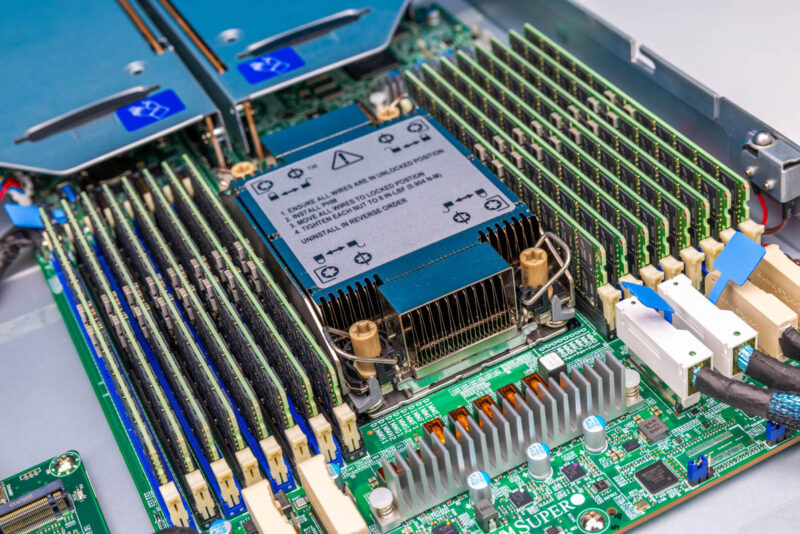
At first, I was probably among those who did not fully understand the Granite Rapids-SP platform. Now, I understand it, especially for those who are power-constrained but still want enormous consolidation benefits with newer hardware. While Intel Xeon 6 does not have clear leadership over AMD EPYC across all categories, Intel has something that will be competitive in the market.




Another great analysis
These’ll outsell the 6900 series by many times. They’re not sexy but they’re enough for most people.
I’m still believing that the issue is the price of the newer chips. We used to be able to buy mid-ranged servers for under $5k. Now you’re talking $15k-20k. It’s great if they’re offering consolidation, but nobody wants to open their wallet on legacy CPU compute if they’re paying as much as they did for the older servers that are all running fine
You’ve colored me intrigued with this R1S business
Just want to say 8-socket 6700/86core, 4TB each.
It’s 688 cores and 32TB in a single x86 server pulling 2800W for CPU alone.
Some day I’d like to see that system, not that my budgets ever include that kind of thing, what use case? Some accounting program, or day-trading bot that wants a thread per trade which somehow is coded only in x86. VDI for 600 users on a single server? I mean you could run 1000 web servers, but why on this instead of a bunch of 1-2U servers. Same with container apps at AWS. what’s the use case?
Supermicro did this on Xeon 4th gen – 6U, 4x mainboard modular trays, vertical pcie in the back of the thing.
Honestly single socket systems are my favorite thing.
And a single socket system with enough PCIe bandwidth to have nearly zero restrictions on throughput between storage and networking is fantastic.
MDF it’s mostly apps like SAP HANA where you need so much memory in a single node. That’s why the cloud co’s all have instances with 4P and 8P. It’s a low volume business but high in the almighty dollar
@Jed J
I don’t know about that. The four customers that buy more than 50% of all servers worldwide primarily ship the highest density processors they can get their hands on. The Xeon 6900 parts are bought mostly by hyperscalers, these small baby xeons are designed for the rest of the market which is becoming so small they’re practically a footnote in server design. Thats why these launched so far later than the higher volume 6900 parts did.
The P-core parts with AMX are great for AI prototyping. GPUs with large GRAM are not very accessible under 10k.
I’d like to see how fast non-distilled AI interference runs on these SKUs.
The full models have 600 billion or more parameters, require 1TB RAM and could demonstrate the matrix hardware built-in. A comparison to the performance of large Power10 systems that also have built-in matrix units would be interesting as well as recent EPYC processors.
Xeon® 6787P High Priority Cores 36C C Low Priority Cores 50C P/E core?????????
Eric – good idea.
argus – I have an e-mail out to Intel on that. I think it is part of the power saving mode which one can select in BIOS, but will confirm. If you look at the Xeon 6781P we have the topology map on, those are all P-cores even though that has high and low priority as well.
Regarding to the high/low priority cores, it is part of the Speed Select Technology. By default, all cores are set to the same priority with the same base frequency and turbo frequency behavior. In some scenarios, the user may do bind their application process to a few cores and running at higher base or turbo frequency. They can set these cores to high priority (HP). Basically, it is about allocation of power budget. When some cores are running at higher frequency, some cores must give up some power budget and running at lower frequency. https://www.kernel.org/doc/Documentation/admin-guide/pm/intel-speed-select.rst